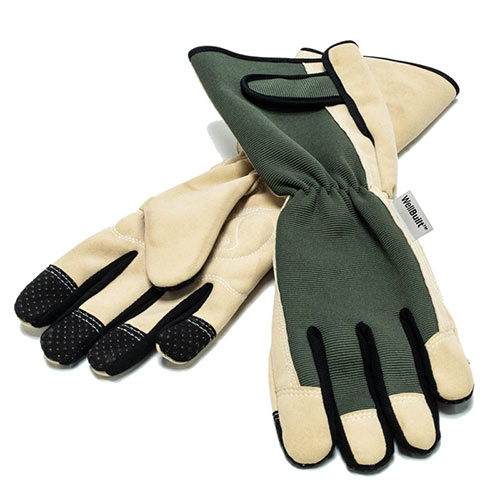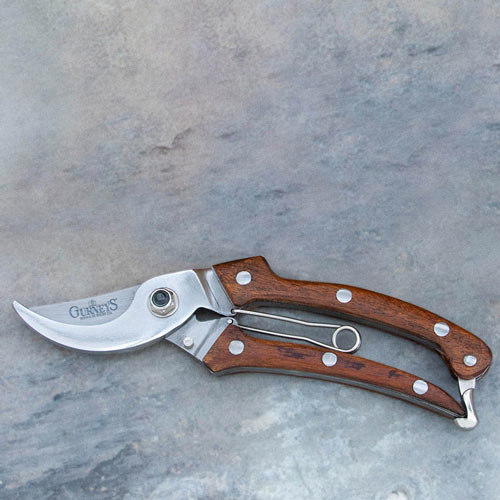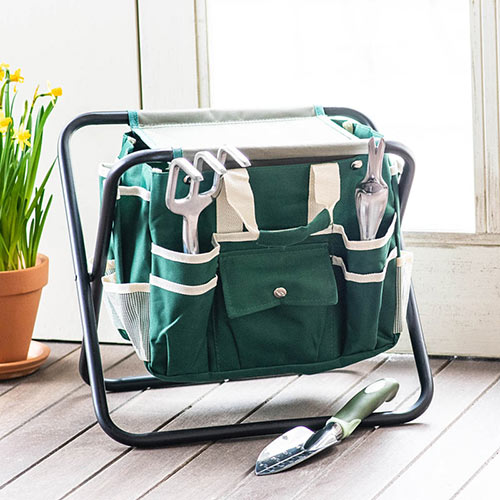What to Do When Asters Get Too Tall
-
Helpful Products from Gardens Alive!
-
 WellBuilt™ Gauntlet Gloves
WellBuilt™ Gauntlet Gloves -
 Rosewood Pruner
Rosewood Pruner -
 Essential Garden Seat with Tools
Essential Garden Seat with Tools
Q. Peter from the Pottawattamie Park Advisory Council in the Rogers Park neighborhood of Chicago writes: "Greetings to Mike and the You Bet Your Garden team!
"We're working in one of our neighborhood parks, rehabilitating and enhancing the landscape and gardens. Three years ago we removed some overgrown yews, which shocked the neighbors as they didn't realize the building next to the yews had any windows!
(Mike interrupts: I have to say that you're being very nonchalant in your report of the yew removal, especially considering the height you describe. I 'inherited' two 'prostrate' yews when I bought our house back in the eighties and it took me years to get their roots out of the ground. Next to wisteria, they are the most tenacious plants I have ever had to tackle! Next time I have an impossible-to-remove plant, I'm calling Chicago!)
Back to Peter: "Two years ago we planted New England Aster plugs from a mail order nursery in their place. The problem is that they grew really well; four feet tall in their very first year. In their second year, they reached eight feet tall but then they started to bend over just as they flowered in October! (These wonderful asters are in a rich, loamy well-draining sandy soil in full sun.)
"I've heard that you can prune Asters to keep them short and bushy. The question is when should we do this? And is this a one-time pinching of the shoots as the plants grow? Or is it a continuous process throughout the growing season?
"Thanks for any advice you can offer on our asters."
A. Thank you, Peter, for a well-timed question. Whenever a plant blooms very late in the season, Spring is the time to prepare it to put on its best show in the Fall.
Although a surprising number of sources encourage gardeners to prune their asters back to the ground after the first freeze of winter, that's bad advice for any plant, especially in Chicago, where cold winters and legendary winds combine to challenge the survival of many perennials.
I've said it many times, but it's always good to repeat: Do not 'clean up' your garden in the Fall! Yes, that bad advice is very attractive to bored gardeners who want to spend more time outside before winter arrives, but it can be fatal to the plants they lovingly attack.
Deadheading of old flowers IS recommended, but again, many sources will urge you to remove those faded flowers right after the first hard freeze. But doing so denies wild birds the abundant natural seed in those faded flowers. And the plant in question is native, meaning that your birds and those seeds have coexisted for centuries.
If the sight of old blooms doth offend thine eyes, you can pinch off the dead flowers a month or so later, but resist the urge to prune the plants themselves.
Chicago winters can be nasty, and you want your perennials to have the best possible chance of survival, which means leaving their stems in place to capture as much snow as possible overtop of their crowns.
If you cut everything back to the ground at the end of the season, you lose those stems and expose the crown of the plants to severe winter injury--especially if the weather is cold and windy without any snow cover. You always want as much upright plant material as possible to catch and collect snow and help insulate those crowns against temperature swings.
The time to prune is in the Spring, long after all possibility of a late frost is gone. Because they are late bloomers, there are no flower buds to worry about, so feel free to reduce the plants to half their size. This action alone should result in bushier plants.
To achieve the best bushiness as opposed to bending over, start pinching the plants back by literally using your thumb and forefinger to pinch off the ends of branches. You can also cut some branches back to improve the shape of the plant and to keep the height around that ideal four to five feet. The more pinching, the more compact the plant, and the less likely it is to flop over. (Like topiary, where constant pinching and light pruning of wayward parts throughout the season is necessary to maintain a desired shape.)
Pinching back is also the way to make hardy mums look the way they did when you bought them back in the Fall, instead of the ungodly mess they turn into when left to their own resources.
Stop pinching and pruning around mid-July and allow the flowers to appear. There should be lots more of them now, and they should be more closely packed together.
And we congratulate you on your choice of plants! Asters are not only native but they're in bloom when other flowers are scarce, and bees and butterflies are still looking for food. They're also host plants for many kinds of butterfly caterpillars.
Note: Aster clumps become crowded over time, reducing flowering and increasing the risk of lankiness. Plan to dig them up and divide them in the Spring in their fourth or fifth year. Replant some in the same spot and move the rest to other parts of the garden.
"We're working in one of our neighborhood parks, rehabilitating and enhancing the landscape and gardens. Three years ago we removed some overgrown yews, which shocked the neighbors as they didn't realize the building next to the yews had any windows!
(Mike interrupts: I have to say that you're being very nonchalant in your report of the yew removal, especially considering the height you describe. I 'inherited' two 'prostrate' yews when I bought our house back in the eighties and it took me years to get their roots out of the ground. Next to wisteria, they are the most tenacious plants I have ever had to tackle! Next time I have an impossible-to-remove plant, I'm calling Chicago!)
Back to Peter: "Two years ago we planted New England Aster plugs from a mail order nursery in their place. The problem is that they grew really well; four feet tall in their very first year. In their second year, they reached eight feet tall but then they started to bend over just as they flowered in October! (These wonderful asters are in a rich, loamy well-draining sandy soil in full sun.)
"I've heard that you can prune Asters to keep them short and bushy. The question is when should we do this? And is this a one-time pinching of the shoots as the plants grow? Or is it a continuous process throughout the growing season?
"Thanks for any advice you can offer on our asters."
A. Thank you, Peter, for a well-timed question. Whenever a plant blooms very late in the season, Spring is the time to prepare it to put on its best show in the Fall.
Although a surprising number of sources encourage gardeners to prune their asters back to the ground after the first freeze of winter, that's bad advice for any plant, especially in Chicago, where cold winters and legendary winds combine to challenge the survival of many perennials.
I've said it many times, but it's always good to repeat: Do not 'clean up' your garden in the Fall! Yes, that bad advice is very attractive to bored gardeners who want to spend more time outside before winter arrives, but it can be fatal to the plants they lovingly attack.
Deadheading of old flowers IS recommended, but again, many sources will urge you to remove those faded flowers right after the first hard freeze. But doing so denies wild birds the abundant natural seed in those faded flowers. And the plant in question is native, meaning that your birds and those seeds have coexisted for centuries.
If the sight of old blooms doth offend thine eyes, you can pinch off the dead flowers a month or so later, but resist the urge to prune the plants themselves.
Chicago winters can be nasty, and you want your perennials to have the best possible chance of survival, which means leaving their stems in place to capture as much snow as possible overtop of their crowns.
If you cut everything back to the ground at the end of the season, you lose those stems and expose the crown of the plants to severe winter injury--especially if the weather is cold and windy without any snow cover. You always want as much upright plant material as possible to catch and collect snow and help insulate those crowns against temperature swings.
The time to prune is in the Spring, long after all possibility of a late frost is gone. Because they are late bloomers, there are no flower buds to worry about, so feel free to reduce the plants to half their size. This action alone should result in bushier plants.
To achieve the best bushiness as opposed to bending over, start pinching the plants back by literally using your thumb and forefinger to pinch off the ends of branches. You can also cut some branches back to improve the shape of the plant and to keep the height around that ideal four to five feet. The more pinching, the more compact the plant, and the less likely it is to flop over. (Like topiary, where constant pinching and light pruning of wayward parts throughout the season is necessary to maintain a desired shape.)
Pinching back is also the way to make hardy mums look the way they did when you bought them back in the Fall, instead of the ungodly mess they turn into when left to their own resources.
Stop pinching and pruning around mid-July and allow the flowers to appear. There should be lots more of them now, and they should be more closely packed together.
And we congratulate you on your choice of plants! Asters are not only native but they're in bloom when other flowers are scarce, and bees and butterflies are still looking for food. They're also host plants for many kinds of butterfly caterpillars.
Note: Aster clumps become crowded over time, reducing flowering and increasing the risk of lankiness. Plan to dig them up and divide them in the Spring in their fourth or fifth year. Replant some in the same spot and move the rest to other parts of the garden.
-
Helpful Products from Gardens Alive!
-
 WellBuilt™ Gauntlet Gloves
WellBuilt™ Gauntlet Gloves -
 Rosewood Pruner
Rosewood Pruner -
 Essential Garden Seat with Tools
Essential Garden Seat with Tools







 Gardens Alive! & Supplies
Gardens Alive! & Supplies




